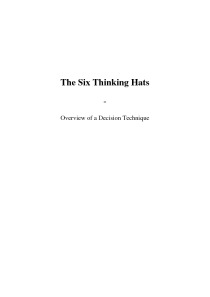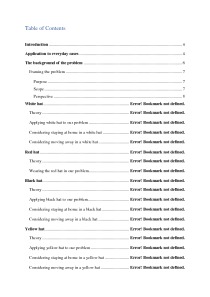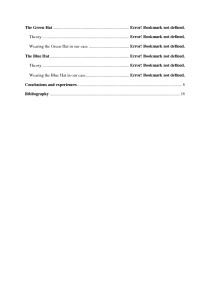The Six Thinking Hats



Introduction. Application to everyday cases. The background of the problem. Framing the problem. Purpose. Scope. Perspective. White hat. Theory. Applying white hat to our problem. Considering staying at home in a white hat. Considering moving away in a white hat. Red hat. Theory. Wearing the red hat in our problem. Black hat. Theory. Applying black hat to our problem. Considering staying at home in a black hat. Considering moving away in a black hat. Yellow hat. Theory. Applying yellow hat to our problem. Considering staying at home in a yellow hat. Considering moving away in a yellow hat. The Green Hat. Theory. Wearing the Green Hat in our case. The Blue Hat. Theory. Wearing the Blue Hat in our case. Conclusions and experiences. Bibliography.
We use it because confusion is the greatest enemy of thinking. When you start thinking about a question or a problem all sorts of thoughts floods your mind. Facts, emotions, feelings, experiences, fears and reasoning all sit around the round table of your mind and make for a vivid and ever-changing conversation together. Six Thinking Hats or Parallel Thinking, invented by Edward de Bono back in 1985, was designed to simplify this multitude of thoughts and help them organize them into a system. The way the technique does this is by separating all these approaches from each other by assigning a colour code to them. You take one approach at once by wearing the coloured hat that matches that kind of thinking, thereby isolating all other thoughts and creating a peace of mind, only concentrating on the one given aspect at a time (Lunsford & Peterson, 1998). Later on, we will break down the process in its details and discuss what wearing each individual hat means.
First, let us discover how do we apply this decision technique in real life. Each of the Six Thinking Hats fills a different role and brings new perspectives for discussion. Although you are able to apply this technique in solving problems and deciding individually, it becomes even more effective when working in – generating ideas, improving team decision–making and improving team meetings. Usually, Six Thinking Hat system is applied to context related to academics, life, career, and business. Through practice and a systematic implementation of this system, the one who applies it will never feel the need to stop searching for an ideal solution to the problems encountered or changing circumstances.
Let us focus on using this tool while working in teams. Especially during period of coronavirus, it is of high important that Six Thinking Hats can be applied both in face to face and virtual practice. According to Academy for Diversity & Innovation, there are 6 different training areas that are described below.
In this section of our assignment, we are going to walk you through what our problem is by generally describing it and also framing it. Our problem deals with the question of where university students should reside during their studies. While most students live at their parents’ house during elementary and high school, things change during the university studies for a number of reasons. Firstly, in contrast to going to an elementary or a high school that is in their town, or just a town away, many students will go to a university that is far away from their home. This is especially true to those who live in the countryside far away from the capital but want to go to a prestigious and renowned university, most of which is located in the city. Given that spending 3 or more hours commuting back and forth between the campus and their home every day of the week is not a sensible option, these students will have to move out of their family homes and look for a new residence elsewhere. A second strong reason as to why university students want to move out is that they want to be independent. It is important to consider that most university students are young adults in their twenties, so this notion of independence is understandable.
- Psichology Individual works
- Microsoft Word 46 KB
- 2021 m.
- English
- 18 pages (6255 words)
- University
- Ainius

















